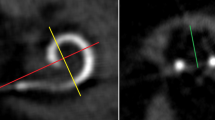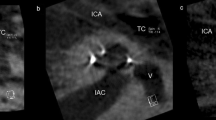Abstract
Objective
Preoperative information about cochlear morphology and size increasingly seems to be a defining factor of electrode choice in cochlear implant surgery. Different types of electrodes differ in length and diameter to accommodate individual cochlear anatomy. Smaller cochlear size results in increased insertion depth with a higher risk to dislocate and causes cochlear trauma with reduced postoperative outcome. The objective of the current study is to describe the three-dimensional size of the cochlea, to compare interindividual differences, to determine the relationship between cochlear size and insertion angle, and to define risk factors for dislocation during insertion.
Design
Four hundred and three patients implanted between 2003 and 2010 inserted via cochleostomy with a perimodiolar electrode array (Cochlear™ Contour Advance® electrode array) have been compared. CBCT (Cone beam computed tomography) was used to determine electrode array position (scala tympani versus scala vestibuli insertion, intracochlear dislocation, and insertion angle) and cochlear size (diameters and height). The trajectory of the electrode array and the lateral wall have been measured, and the position of the electrode array has been estimated.
Results
The mean value of the largest diameter was 9.95 mm and that of the perpendicular distance was 6.54 mm. There was a statistically significant correlation between those values. Mean height was 3.85 mm. The intracochlear relation of the electrode array and the modiolus showed a statistically significant relationship with the cochlear expanse. The electrode array was more likely to dislocate in cochleae with a smaller diameter and a lower height. Cochleae with insertions into scala vestibuli exhibited a smaller height compared to scala tympani insertions with statistical significance.
Conclusion
Cochlear size and shape is variable, and the measured data of this study confirm the finding of other researchers. This study established two heights by two different planes to achieve a three-dimensional understanding of the cochlea. The electrode array was more likely to dislocate in cochleae with smaller diameter and smaller height. It can be assumed that the height established in this study seems to be a new preoperative parameter to underline the risk of scalar dislocation and not favored scala vestibuli insertion if using a cochleostomy approach. In conclusion, cochlear size, especially the height, is influencing the final position of the electrode array. Using preoperative scans of the cochlear diameters and cochlear height, a next step to custom-sized arrays is available.







Similar content being viewed by others
References
Hardy M (1938) The length of the organ of Corti in man. Am J Anat 62:291–311
Dimopoulos P, Muren C (1990) Anatomic variations of the cochlea and relations to other temporal bone structures. Acta Radiol 31:439–444
Xu J, Xu SA, Cohen LT, Clark GM (2000) Cochlear view: postoperative radiography for cochlear implantation. Am J Otol 21:49–56
Kawano A, Seldon HL, Clark GM (1996) Computer-aided three-dimensional construction in human cochlear maps: measurement of the lengths of organ of Corti outer wall, inner wall and Rosenthal´s canal. Ann Otol Rhinol Laryngo 105:701–709
Ketten DR, Skinner MW, Wang G, Vannier MW, Gates GA, Neely JG (1998) In vivo measures of cochlear length and insertion depth of Nucleus cochlear implant electrode arrays. Ann Otol Rhinol Laryngol 107:1–16
Escudé B, James C, Deguine O, Cochard N, Eter E, Fraysse B (2006) The size of the cochlea and predictions of insertion depth angles for cochlea implant electrodes. Audiol Neurootol 11(Suppl 1):27–33
Van der Marel K, Briaire JJ, Wolterbeek R, Snel-Bongers J, Verbist BM, Frijns JHM (2013) Diversity in cochlear morphology and its influence on cochlear implant electrode position. Ear Hear 35:9–20
Würfel W, Lanfermann H, Lenarz T, Majdani O (2014) Cochlear length determination using Cone Beam Computed Tomography in a clinical setting. Hear Res 316:65–72
Kós MI, Broex C, Sigrist A, Guyot JP, Pelizzone M (2005) Measurements of electrode position inside the cochlea for different cochlear implant systems. Acta Otolaryngol 125(5):474–480
James C, Albegger K, Battmer R, Burdo S, Deggouj N, Deguine O, Dillier N, Gersdorff M, Laszig R, Lenarz T, Rodriguez MM, Mondain M, Offeciers E, Macías AR, Ramsden R, Sterkers O, Von Wallenberg E, Weber B, Fraysse B (2005) Preservation of residual hearing with cochlear implantation: how and why. Acta Otolaryngol 125:481–491
Fraysse B, Ramos A, Sterkers O, Burdo S, Ramsden R, Deguine O, Klenzner T, Lenarz T, Rodriguez MM, Von Wallenberg E, James C (2006) Residual hearing conservation and electro-acoustic stimulation with the Nucleus 24 Contour Advance cochlear implant. Otol Neurotol 27:624–633
Finley CC, Holden TA, Holden LK, Whiting BR, Chole RA, Neely GJ et al (2008) Role of electrode placement as a contributor to variability in cochlear implant outcomes. Otol Neurotol 29:920–928
Aschendorff A, Kromeier J, Klenzner T, Laszig R (2007) Quality control after insertion of the nucleus contour and contour advance electrode in adults. Ear Hear 28:75S-79S
Aschendorff A, Kubalek R, Turowski B, Zanella F, Hochmuth A, Schumacher M, Klenzner T, Laszig R (2005). Quality control after cochlear implant surgery by means of rotational tomography. Otol Neurotol 26(1):34–37
Pein MK, Brandt S, Plontke SK, Kösling S (2014) Visualization of subtle temporal bone structures. Comparison of cone beam CT and MDCT. Radiol 54:271–278
Holden LK, Finley CC, Firszt JB, Holden TA, Brenner C, Potts LG, Gotter BD, Vanderhoof SS, Mispagel K, Heydebrand G, Skinner MW (2013) Factors affecting open-set word recognition in adults with cochlear implants. Ear Hear 34:342–360
Strubecker K (1984) Einführung in die höhere Mathematik. 4. Grundzüge der linearen Algebra, Differential- und Integralrechnung der Funktionen von mehreren Veränderlichen. Oldenbourg, Verlag/publisher
Trieger A, Schulze A, Schneider M, Zahnert T, Mürbe D (2010) In vivo measurements of the insertion depth of cochlear implant arrays using flat-panel volume computed tomography. Otol Neurotol 32:152–157
O’Connell BP, Cakir A, Hunter JB et al (2016) Electrode Location and Angular Insertion Depth Are Predictors of Audiologic Outcomes in Cochlear Implantation. Otol Neurotol 2016;37(8):1016–1023
Aschendorff A, Klenzner T, Arndt S, Beck R, Schild C, Röddiger L, Maier W, Laszig R (2011). Insertion results for Contour™ and Contour Advance™ electrodes: are there individual learning curves? HNO 59(5):448–452
Acknowledgements
The authors thank the Fördergesellschaft “Taube Kinder lernen Hören e.V.”, which has supported the cochlear implant rehabilitation center in Freiburg for the past 20 years.
Author information
Authors and Affiliations
Corresponding author
Ethics declarations
Conflict of interest
The author Manuel Christoph Ketterer declares no conflict of interest. A. Aschendorff received travelling expenses, Medical advisory board and financial support for research from Advanced Bionics, Stäfa, Switzerland; financial support for research and travelling expenses from Cochlear Ltd, Australia; financial support for research and travelling expenses fromMed-El, Innsbruck, Austria; travelling expenses and financial support for research from Oticon, Copenhagen, Denmark. S. Arndt received travelling expenses fromAdvanced Bionics, Stäfa, Switzerland; financial support for research and travelling expenses from Cochlear Ltd, Australia; financial support for research and travelling expenses from Med-El, Innsbruck, Austria; and travelling expenses from Oticon, Copenhagen, Denmark. F.Hassepass received travelling expenses from Advanced Bionics, Stäfa, Switzerland and Cochlear Ltd, Australia. T.Wesarg received consultancy fees, financial support for research and travelling expenses from Advanced Bionics, Stäfa, Switzerland; consultancy fees, financial support for research and travelling expenses from Med-El, Innsbruck, Austria; financial support for research and travelling expenses from Phonak Communications, Murten, Switzerland. R. Laszig received financial support for research and travelling expenses from Advanced Bionics, Stäfa, Switzerland; financial support for research, travelling expenses, and consultancy fees fromCochlear Ltd, Australia; travelling expenses fromOticon, Copenhagen, Denmark; financial support for research from Med-El, Innsbruck, Austria; financial support for research and travelling expenses from ARRIAGMunich, Germany; travelling expenses from Otologics Boulder, USA; travelling expenses from SonovaHolding, Stäfa, Switzerland; financial support for research from TKIH, Freiburg, Germany; travelling expenses from the General Secretary of the GermanHNOSociety; contract fees, consultancy fees and travelling costs from Medupdate and fees from Springer Medicine EiC. R. Beck received travelling expenses from Cochlear Ltd, Australia. This study is not sponsored by industry.
Ethical approval
All procedures performed in this study were in accordance with the ethical standards of the institutional and national research committee and with the 1964 Helsinki declaration and its later amendments or comparable ethical standards.
Rights and permissions
About this article
Cite this article
Ketterer, M.C., Aschendorff, A., Arndt, S. et al. The influence of cochlear morphology on the final electrode array position. Eur Arch Otorhinolaryngol 275, 385–394 (2018). https://doi.org/10.1007/s00405-017-4842-y
Received:
Accepted:
Published:
Issue Date:
DOI: https://doi.org/10.1007/s00405-017-4842-y




